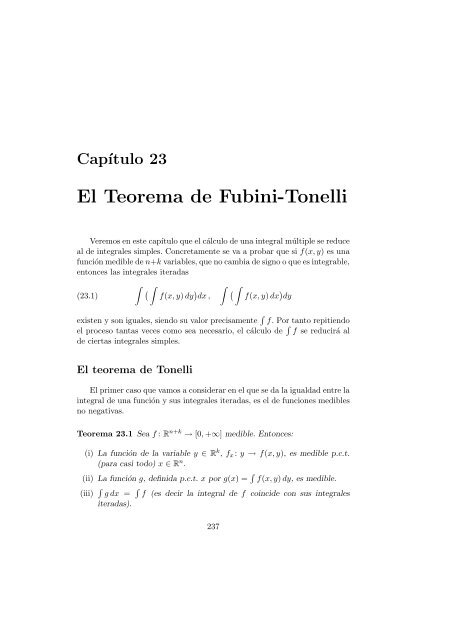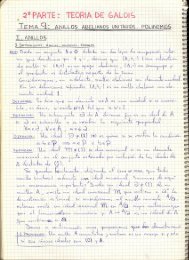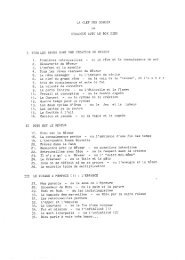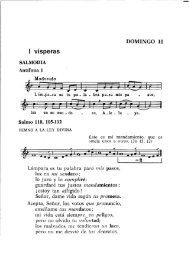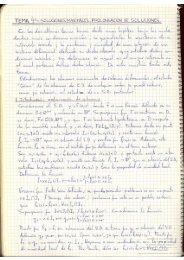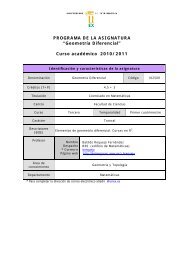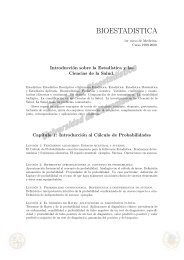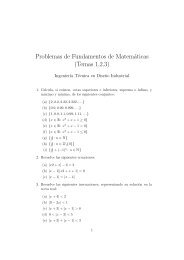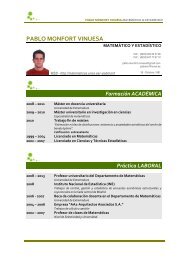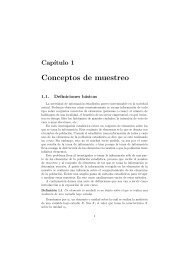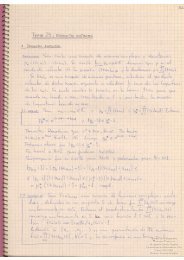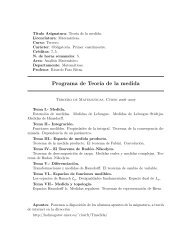El Teorema de Fubini-Tonelli
El Teorema de Fubini-Tonelli
El Teorema de Fubini-Tonelli
Create successful ePaper yourself
Turn your PDF publications into a flip-book with our unique Google optimized e-Paper software.
Capítulo 23<br />
<strong>El</strong> <strong>Teorema</strong> <strong>de</strong> <strong>Fubini</strong>-<strong>Tonelli</strong><br />
Veremos en este capítulo que el cálculo <strong>de</strong> una integral múltiple se reduce<br />
al <strong>de</strong> integrales simples. Concretamente se va a probar que si f(x, y) es una<br />
función medible <strong>de</strong> n+k variables, que no cambia <strong>de</strong> signo o que es integrable,<br />
entonces las integrales iteradas<br />
(23.1)<br />
<br />
f(x, y) dy dx ,<br />
<br />
f(x, y) dx dy<br />
existen y son iguales, siendo su valor precisamente f. Por tanto repitiendo<br />
el proceso tantas veces como sea necesario, el cálculo <strong>de</strong> f se reducirá al<br />
<strong>de</strong> ciertas integrales simples.<br />
<strong>El</strong> teorema <strong>de</strong> <strong>Tonelli</strong><br />
<strong>El</strong> primer caso que vamos a consi<strong>de</strong>rar en el que se da la igualdad entre la<br />
integral <strong>de</strong> una función y sus integrales iteradas, es el <strong>de</strong> funciones medibles<br />
no negativas.<br />
<strong>Teorema</strong> 23.1 Sea f : R n+k → [0, +∞] medible. Entonces:<br />
(i) La función <strong>de</strong> la variable y ∈ R k , fx : y → f(x, y), es medible p.c.t.<br />
(para casi todo) x ∈ R n .<br />
(ii) La función g, <strong>de</strong>finida p.c.t. x por g(x) = f(x, y) dy, es medible.<br />
(iii) g dx = f (es <strong>de</strong>cir la integral <strong>de</strong> f coinci<strong>de</strong> con sus integrales<br />
iteradas).<br />
237
238 <strong>El</strong> <strong>Teorema</strong> <strong>de</strong> <strong>Fubini</strong>-<strong>Tonelli</strong> 23.1<br />
La <strong>de</strong>mostración <strong>de</strong>l teorema general pue<strong>de</strong> reducirse al caso particular en<br />
que f = XE, la función característica <strong>de</strong> un conjunto medible, utilizando los<br />
siguientes hecho:<br />
23.2 (a) Si las funciones f, g ≥ 0 satisfacen el teorema <strong>de</strong> <strong>Tonelli</strong>, entonces<br />
también lo satisface toda función <strong>de</strong>l tipo af + b g, para todos a, b ≥ 0.<br />
(b) Si {fk} es una sucesión monótona creciente <strong>de</strong> funciones no negativas<br />
que satisfacen el teorema <strong>de</strong> <strong>Tonelli</strong>, entonces también lo satisface la<br />
función f = límk→∞ fk.<br />
(c) Si {fk} es una sucesión monótona <strong>de</strong>creciente <strong>de</strong> funciones no negativas,<br />
acotadas y con soporte compacto que satisfacen el teorema <strong>de</strong><br />
<strong>Tonelli</strong>, entonces también lo satisface la función f = límk→∞ fk.<br />
(d) Si {fk} es una sucesión <strong>de</strong> funciones no negativas que satisfacen el<br />
teorema <strong>de</strong> <strong>Tonelli</strong>, entonces también lo satisface la función f = fk.<br />
Demostración. (a) Supongamos que las funciones f, g satisfacen el teorema<br />
<strong>de</strong> F-T y veamos que la función f + g también lo satisface:<br />
Sea<br />
N = {x ∈ R n : fx no es [y]-medible} ∪ {x ∈ R n : gx no es [y]-medible}.<br />
Por hipótesis N es <strong>de</strong> medida nula. Es claro entonces que si x ∈ N, la<br />
función <strong>de</strong> y, fx + gx es medible. Con otras palabras las funciones fx + gx<br />
son medible p.c.t. x. Puesto que f, g satisfacen F-T, la función h <strong>de</strong>finida<br />
c.s mediante, h(x) = (fx + gx)(y)dy = f(x, y)dy + g(x, y)dy, es la<br />
suma <strong>de</strong> las funciones [x]-medibles y no negativas h1(x) = f(x, y)dy y<br />
h2(x) = g(x, y)dy y por tanto es una función medible. Por último<br />
<br />
<br />
(f + g)(x, y)dy <br />
dx =<br />
<br />
h(x)dx = (h1(x) + h2(x))dx<br />
<br />
=<br />
<br />
h1(x)dx +<br />
<br />
<br />
h2(x)dx = f(x, y)dy <br />
<br />
dx + g(x, y)dy dx<br />
<br />
<br />
<br />
= f(x, y)dxdy + g(x, y)dxdy = (f + g)(x, y)dxdy.<br />
(b) y (c) La técnica <strong>de</strong> la <strong>de</strong>mostración es similar en ambos casos y<br />
está basada en el teorema <strong>de</strong> la convergencia monótona y en <strong>de</strong> la convergencia<br />
dominada. Demostraremos (c), que es algo más compleja:<br />
Observemos en primer lugar que se pue<strong>de</strong> aplicar el teorema <strong>de</strong> la convergencia<br />
dominada a la sucesión, ya que para cada k, 0 ≤ fk ≤ f1 y f1 es
23.3 <strong>El</strong> <strong>Teorema</strong> <strong>de</strong> <strong>Fubini</strong>-<strong>Tonelli</strong> 239<br />
integrable (por ser acotada y <strong>de</strong> soporte acotado). Luego<br />
<br />
f = lím fk.<br />
k→∞<br />
Denotemos Nk = {x ∈ Rn : (fk)x no es medible}. Por hipótesis cada uno <strong>de</strong><br />
estos conjuntos es <strong>de</strong> medida nula. Es claro entonces que si x ∈ N = ∪Nk,<br />
la sucesión <strong>de</strong>creciente <strong>de</strong> funciones <strong>de</strong> y, (fk)x, es medible, y por tanto su<br />
límite fx también. Se tiene pues que fx es medible para c.t. x. Razonando<br />
como antes, a la sucesión (fk)x se pue<strong>de</strong> aplicar también el teorema <strong>de</strong> la<br />
convergencia dominada, por lo que si x ∈ N<br />
<br />
<br />
fx(y)dy = lím (fk)x(y)dy.<br />
k→∞<br />
Una vez más, teniendo en cuenta que las funciones fk satisfacen el teorema<br />
<strong>de</strong> F-T, la sucesión <strong>de</strong>creciente <strong>de</strong> funciones <strong>de</strong> x <strong>de</strong>finidas c.s. por<br />
gk(x) = fk(x, y)dy está formada por funciones [x]-medibles, su límite<br />
g(x) c.s.<br />
= fx(y)dy es medible y, aplicando el teorema <strong>de</strong> la convergencia<br />
dominada, resulta que<br />
<br />
<br />
f(x, y)dy <br />
<br />
dx = g(x)dx = lím gk(x)dx<br />
k→∞<br />
<br />
<br />
= lím fk(x, y)dy<br />
k→∞<br />
<br />
<br />
dx = lím fk(x, y)dxdy = f(x, y)dxdy<br />
k→∞<br />
(d) Es consecuencia directa <strong>de</strong> (a) y (b).<br />
Como consecuencia <strong>de</strong> este resultado, la <strong>de</strong>mostración <strong>de</strong>l teorema <strong>de</strong> <strong>Tonelli</strong><br />
bastará hacerla para funciones <strong>de</strong>l tipo f = XE. En efecto, éste podría<br />
exten<strong>de</strong>rse ya a las funciones simples no negativas. A<strong>de</strong>más si f es una<br />
función medible no negativa sabemos que existe una sucesión creciente {sk}<br />
<strong>de</strong> funciones simples no negativas que converge puntualmente a f. Luego<br />
por (b) el teorema <strong>de</strong> F-T se exten<strong>de</strong>ría también a f.<br />
Lema 23.3 Si E ⊂ R n+k es un conjunto medible, entonces el teorema <strong>de</strong><br />
<strong>Tonelli</strong> se satisface para la función XE.<br />
Demostración. Vamos a ver que para probar el lema bastará ver que éste es<br />
cierto cuando E es el producto <strong>de</strong> dos semintervalos:<br />
1. En primer lugar observemos que bastaría probar el lema para conjuntos<br />
medibles y acotados. En efecto si E es medible, sea Ek = E ∩ {x : x ≤<br />
k}, k = 1, 2, . . .. Entonces es obvio que<br />
XE1<br />
≤ XE2 ≤ . . . ≤ XEk ≤ . . . → XE,
240 <strong>El</strong> <strong>Teorema</strong> <strong>de</strong> <strong>Fubini</strong>-<strong>Tonelli</strong> 23.1<br />
por lo que aplicando (b) <strong>de</strong> 23.2 se <strong>de</strong>duce que si XEk satisface F-T, entonces<br />
también lo satisface XE.<br />
2. Sea entonces E medible y acotado. Se pue<strong>de</strong> encontrar un conjunto<br />
Gδ y acotado G ⊃ E tal que el conjunto N = G \ E es <strong>de</strong> medida nula,<br />
luego XE = XG − XN. De nuevo, teniendo en cuenta el apartado (a) <strong>de</strong> 23.2,<br />
para probar que XE satisface F-T bastará que lo satisfagan las funciones<br />
características <strong>de</strong> conjuntos acotados <strong>de</strong>l tipo Gδ o <strong>de</strong> medida nula.<br />
3. Si G es un conjunto acotado y Gδ, entonces es fácil ver que existe una<br />
sucesión <strong>de</strong> abiertos acotados {Uk} tal que<br />
XU1<br />
≥ XU2 ≥ . . . ≥ XUk ≥ . . . → XG.<br />
En virtud <strong>de</strong>l apartado (c) <strong>de</strong> 23.2, bastará que la función característica <strong>de</strong><br />
conjuntos abiertos satisfagan F-T para que también lo satisfaga XG.<br />
4. Si U es abierto, entonces U = ∪Ck don<strong>de</strong> los conjuntos Ck son (n+p)semicubos<br />
disjuntos dos a dos. Luego<br />
XU = XCk .<br />
De nuevo, utilizando (d) <strong>de</strong> 23.2, bastará que las funciones características<br />
<strong>de</strong> semintervalos <strong>de</strong> R n ×R p satisfagan F-T para garantizar que XU también<br />
lo satisface.<br />
5. Si E es un subconjunto <strong>de</strong> R n+k y x ∈ R n , escribiremos E(x) = {y ∈<br />
R k : (x, y) ∈ E}. Análogamente E(y). Puesto que el conjunto E es medible<br />
si y sólo si XE es una función medible, el teorema 23.1 para f = XE se<br />
enuncia entonces así: Si E ⊂ R n+k es un conjunto medible, entonces<br />
(i) <strong>El</strong> conjunto E(x) es medible p.c.t. x ∈ R n .<br />
(ii) La función g(x) = m ∗ (E(x)), es medible.<br />
(iii) m(E) = m ∗ (E(x))dx .<br />
6. Sea E = I × J un semintervalo <strong>de</strong> Rn × Rp y veamos que E satisface<br />
F-T:<br />
<br />
J si x ∈ I<br />
E(x) =<br />
⇒ g(x) = m(E(x)) = m(J)XI(x).<br />
∅ si x ∈ I<br />
g es pues una función simple y su integral, g = m(J) · m(I) = m(E).<br />
7. Por último veamos que si N es acotado y <strong>de</strong> medida nula la función<br />
XN satisface F-T:
23.4 <strong>El</strong> <strong>Teorema</strong> <strong>de</strong> <strong>Fubini</strong>-<strong>Tonelli</strong> 241<br />
Sea G un conjunto acotado y Gδ tal que N ⊂ G y m(G) = 0. Como G<br />
satisface el teorema, entonces<br />
<br />
0 = m(G) = m(G(x))dx<br />
<strong>de</strong> lo que se <strong>de</strong>duce que G(x) y también N(x) ⊂ G(x) son <strong>de</strong> medida nula<br />
p.c.t. x (ver Proposición 22.7). Por tanto, N(x) medible p.c.t. x, g(x) =<br />
m(N(x)) = 0 c.s., (luego g es medible) y g = 0 = m(N).<br />
<strong>El</strong> teorema <strong>de</strong> <strong>Fubini</strong><br />
Como ya señalamos al principio las integrales iteradas también coinci<strong>de</strong>n<br />
con la integral <strong>de</strong> la función cuando ésta es una función integrable. <strong>El</strong><br />
enunciado preciso <strong>de</strong> este hecho lo constituye el teorema <strong>de</strong> <strong>Fubini</strong>:<br />
<strong>Teorema</strong> 23.4 Sea f : R n+k → R integrable. Entonces:<br />
(i) La función <strong>de</strong> la variable y ∈ R k , f(x, −): y → f(x, y), es integrable<br />
p.c.t. x ∈ R n .<br />
(ii) La función g, <strong>de</strong>finida p.c.t. x por g(x) = f(x, y) dy, es integrable.<br />
(iii) g dx = f (es <strong>de</strong>cir la integral <strong>de</strong> f coinci<strong>de</strong> con sus integrales<br />
iteradas).<br />
Demostración. Sea f = f + − f − . Por hipótesis f + y f − son integrables y<br />
al ser también no negativas, satisfacen el teorema <strong>de</strong> <strong>Tonelli</strong>, es <strong>de</strong>cir<br />
<br />
<br />
f + (x, y) dy <br />
dx = f + < +∞ ,<br />
<br />
<br />
f − (x, y) dy <br />
dx = f − < +∞,<br />
por tanto, si <strong>de</strong>notamos por g1(x) = f + (x, y) dy, se tiene que g1 es una<br />
función <strong>de</strong> x integrable y en consecuencia finita c.s.(ver ejercicio 22P) o lo<br />
que es lo mismo f + (x, −) es integrable p.c.t. x. Análogamente se prueba que<br />
f − (x, −) es integrable p.c.t. x y g2(x) = f − (x, y) dy es integrable, luego<br />
f(x, −) = f + (x, −) − f − (x, −) es integrable p.c.t. x. La función<br />
<br />
g(x) =<br />
<br />
f(x, y) dy =<br />
f + <br />
(x, y) dy −<br />
f − (x, y) dy = g1(x) − g2(x)
242 <strong>El</strong> <strong>Teorema</strong> <strong>de</strong> <strong>Fubini</strong>-<strong>Tonelli</strong> 23D<br />
está <strong>de</strong>finida c.s. y es integrable, por ser diferencia <strong>de</strong> dos funciones integrables.<br />
Por último,<br />
<br />
<br />
<br />
g(x) dx = g1(x) dx − g2(x) dx<br />
<br />
<br />
= f + (x, y) dy <br />
<br />
dx − f − (x, y) dy <br />
dx = f + <br />
− f − <br />
=<br />
Nota. Para aplicar el teorema <strong>de</strong> <strong>Fubini</strong>-<strong>Tonelli</strong> a funciones cuyo dominio<br />
no es todo R n+k , basta tener en cuenta la fórmula<br />
<br />
E<br />
<br />
f =<br />
fXE.<br />
Por tanto, si f ≥ 0 o integrable sobre el conjunto medible E, se tiene que<br />
<br />
E<br />
<br />
f =<br />
<br />
<br />
fXE =<br />
E(x)<br />
f(x, y)dy <br />
dx =<br />
A<br />
<br />
E(x)<br />
f(x, y)dy dx,<br />
don<strong>de</strong> A = {x ∈ R n : m(E(x)) > 0}. Los conjuntos A y E(x) son “los<br />
límites <strong>de</strong> integración”, y el proceso <strong>de</strong>scrito para su obtención será el que<br />
se seguirá habitualmente en la práctica.<br />
Ejercicios<br />
23A Sea E un subconjunto medible <strong>de</strong> R n+k . Probar que E es <strong>de</strong> medida nula si<br />
y sólo p.c.t x ∈ R n , m(E(x)) = 0.<br />
23B Sean A, B subconjuntos cualesquieras <strong>de</strong> R n y R k respectivamente, G un<br />
conjunto medible tal que A × B ⊂ G y m ∗ (A × B) = m(G) y g(x) = m ∗ (G(x)).<br />
Probar que A × [0, m ∗ (B)] ⊂ Ord (g) y <strong>de</strong>ducir <strong>de</strong> esto la fórmula<br />
m ∗ (A × B) = m ∗ (A) · m ∗ (B).<br />
f.
23I <strong>El</strong> <strong>Teorema</strong> <strong>de</strong> <strong>Fubini</strong>-<strong>Tonelli</strong> 243<br />
23C Consi<strong>de</strong>remos la función<br />
f(x, y) = y2 − x2 (x2 + y2 .<br />
) 2<br />
Probar las dos integrales iteradas <strong>de</strong> f sobre el conjunto B = [0, 1] × [0, 1] existen<br />
pero son diferentes.<br />
23D Sea f una función medible. Probar que f es integrable si y sólo si alguna <strong>de</strong><br />
las integrales iteradas <strong>de</strong> la función |f| es finita.<br />
23E Determinar el recinto B para que<br />
<br />
1 <br />
f(x, y)dxdy =<br />
x<br />
f(x, y)dy dx<br />
B<br />
0<br />
23F (a) Probar que en las condiciones <strong>de</strong> aplicabilidad <strong>de</strong>l teorema <strong>de</strong> <strong>Fubini</strong>-<br />
<strong>Tonelli</strong>, se tiene que<br />
b x<br />
f(x, y)dy b <br />
dx =<br />
b<br />
f(x, y)dx dy<br />
a<br />
a<br />
(b) Deducir que si f(x, y) = f(y, x) en el rectángulo B = [a, b] × [a, b] entonces<br />
el valor común <strong>de</strong> las integrales anteriores es<br />
<br />
1<br />
f(x, y)dxdy.<br />
2<br />
(c) En particular, <strong>de</strong>mostrar que si a > 0 entonces<br />
a a<br />
f(y)<br />
y dy a<br />
dx = f(x)dx.<br />
0<br />
23G Calcular el área limitada por las gráficas <strong>de</strong> las funciones<br />
y la recta x = 1.<br />
f(x) =<br />
x<br />
B<br />
x 2<br />
1<br />
x √ 1<br />
, g(x) =<br />
1 − x x<br />
23H Hallar <br />
yzdxdydz,<br />
D<br />
don<strong>de</strong> D es el recinto limitado por los planos coor<strong>de</strong>nados y los planos x + y = 1 y<br />
z = 4.<br />
23I Calcular <br />
sen(x + y)dxdy,<br />
B<br />
don<strong>de</strong> B = {(x, y): 0 ≤ x ≤ y; 0 ≤ y ≤ 1; x + y ≤ π/2}.<br />
a<br />
0<br />
y


